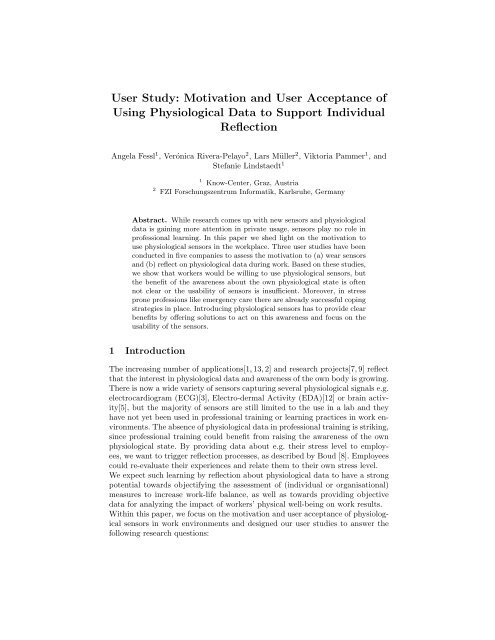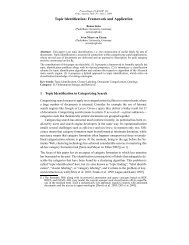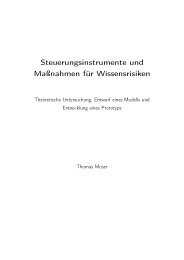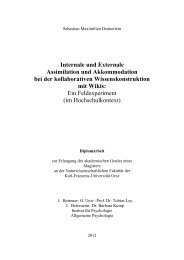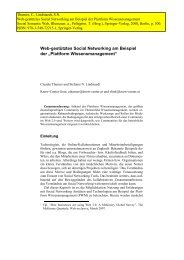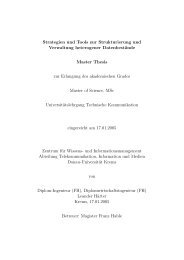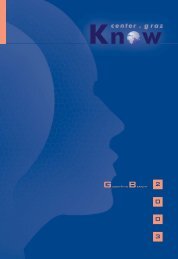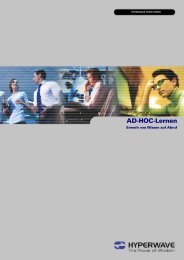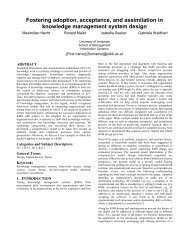Motivation and User Acceptance of Using ... - Know-Center
Motivation and User Acceptance of Using ... - Know-Center
Motivation and User Acceptance of Using ... - Know-Center
You also want an ePaper? Increase the reach of your titles
YUMPU automatically turns print PDFs into web optimized ePapers that Google loves.
<strong>User</strong> Study: <strong>Motivation</strong> <strong>and</strong> <strong>User</strong> <strong>Acceptance</strong> <strong>of</strong><br />
<strong>Using</strong> Physiological Data to Support Individual<br />
Reflection<br />
Angela Fessl 1 , Verónica Rivera-Pelayo 2 , Lars Müller 2 , Viktoria Pammer 1 , <strong>and</strong><br />
Stefanie Lindstaedt 1<br />
1 <strong>Know</strong>-<strong>Center</strong>, Graz, Austria<br />
2 FZI Forschungszentrum Informatik, Karlsruhe, Germany<br />
Abstract. While research comes up with new sensors <strong>and</strong> physiological<br />
data is gaining more attention in private usage, sensors play no role in<br />
pr<strong>of</strong>essional learning. In this paper we shed light on the motivation to<br />
use physiological sensors in the workplace. Three user studies have been<br />
conducted in five companies to assess the motivation to (a) wear sensors<br />
<strong>and</strong> (b) reflect on physiological data during work. Based on these studies,<br />
we show that workers would be willing to use physiological sensors, but<br />
the benefit <strong>of</strong> the awareness about the own physiological state is <strong>of</strong>ten<br />
not clear or the usability <strong>of</strong> sensors is insufficient. Moreover, in stress<br />
prone pr<strong>of</strong>essions like emergency care there are already successful coping<br />
strategies in place. Introducing physiological sensors has to provide clear<br />
benefits by <strong>of</strong>fering solutions to act on this awareness <strong>and</strong> focus on the<br />
usability <strong>of</strong> the sensors.<br />
1 Introduction<br />
The increasing number <strong>of</strong> applications[1, 13, 2] <strong>and</strong> research projects[7, 9] reflect<br />
that the interest in physiological data <strong>and</strong> awareness <strong>of</strong> the own body is growing.<br />
There is now a wide variety <strong>of</strong> sensors capturing several physiological signals e.g.<br />
electrocardiogram (ECG)[3], Electro-dermal Activity (EDA)[12] or brain activity[5],<br />
but the majority <strong>of</strong> sensors are still limited to the use in a lab <strong>and</strong> they<br />
have not yet been used in pr<strong>of</strong>essional training or learning practices in work environments.<br />
The absence <strong>of</strong> physiological data in pr<strong>of</strong>essional training is striking,<br />
since pr<strong>of</strong>essional training could benefit from raising the awareness <strong>of</strong> the own<br />
physiological state. By providing data about e.g. their stress level to employees,<br />
we want to trigger reflection processes, as described by Boud [8]. Employees<br />
could re-evaluate their experiences <strong>and</strong> relate them to their own stress level.<br />
We expect such learning by reflection about physiological data to have a strong<br />
potential towards objectifying the assessment <strong>of</strong> (individual or organisational)<br />
measures to increase work-life balance, as well as towards providing objective<br />
data for analyzing the impact <strong>of</strong> workers’ physical well-being on work results.<br />
Within this paper, we focus on the motivation <strong>and</strong> user acceptance <strong>of</strong> physiological<br />
sensors in work environments <strong>and</strong> designed our user studies to answer the<br />
following research questions:
1. Would potential users actually wear (=use) physiological sensors at work?<br />
2. Do potential users see a benefit in analyzing physiological data?<br />
Note that this paper integrates results that were reported in two separate<br />
project deliverables <strong>of</strong> the MIRROR project ([10, 11]) <strong>and</strong> provides an additional<br />
discussion that became possible through this integration.<br />
2 Scope <strong>of</strong> Application<br />
Five European companies in different sizes, from different sectors <strong>and</strong> countries<br />
have been chosen to analyze the acceptance <strong>of</strong> physiological sensors at the workplace.<br />
This wide selection <strong>of</strong> companies should help us to generalize our findings.<br />
NBN The Stroke Unit (SU) at the Neurologische Klinik Bad Neustadt (NBN) in<br />
Germany, deals with neurological emergencies especially with the treatment<br />
<strong>of</strong> strokes. The target group in the below-described studies are physicians,<br />
nurses <strong>and</strong> therapists working at the SU.<br />
RNHA The Registered Nursing Home Association (RNHA) is a group <strong>of</strong> registered<br />
nursing homes in the UK. The residents are elderly people, many<br />
<strong>of</strong> them suffering from dementia. The target group in the below-described<br />
studies are the carers <strong>and</strong> nurses working at RNHA.<br />
REG Regola (REG) is an Italian s<strong>of</strong>tware company that provides IT solutions<br />
for the health <strong>and</strong> emergency management sector. The target group in the<br />
below-described studies are the employees <strong>of</strong> REG.<br />
BT The British Telecom (BT) center in the Netherl<strong>and</strong>s has 1500 large <strong>and</strong><br />
customized contracts that are managed by contract teams. The target group<br />
in the below-described studies are the members <strong>of</strong> these contract teams.<br />
INFOM The Infoman AG (INFOM) is an German IT consulting company<br />
with the objective to analyse <strong>and</strong> optimise the marketing, sales <strong>and</strong> service<br />
processes <strong>of</strong> their customers. The target group in the below-described studies<br />
are consultant <strong>and</strong> sales persons working at Infoman.<br />
3 Method <strong>and</strong> Samples<br />
Our research followed a three step approach. In a first step, a questionnaire was<br />
distributed in all testbeds, i.e. all the companies, to collect the specific attitude<br />
towards the use <strong>of</strong> physiological sensors. In a second step, we equipped nurses <strong>and</strong><br />
physician <strong>of</strong> one testbed with sensors <strong>and</strong> interviewed them afterwards. Finally,<br />
the results <strong>and</strong> the specific use <strong>of</strong> this data for reflection was discussed in three<br />
focus groups.<br />
3.1 Questionnaire<br />
Method The general acceptance <strong>of</strong> sensors was evaluated in all testbeds. All<br />
questions could be answered on a 5 point Likert-type scale (strongly disagree,
disagree, neutral, agree, strongly agree). A questionnaire with the following questions<br />
was sent to four testbeds: (1) I would be willing to wear sensors for a certain<br />
time. (2) I would wear such sensors only if it was m<strong>and</strong>atory. (3) Wearing such<br />
sensors would be uncomfortable in my job. (4) I would wear sensors if they help<br />
me with my daily work. (5) I would wear sensors if they help others at work.<br />
A shorter questionnaire with easier language was was used for RNHA. Due to<br />
the specific nature <strong>of</strong> RNHA - mainly a lower level <strong>of</strong> education <strong>and</strong> concerns<br />
about the level <strong>of</strong> literacy. The modifications were well received by the testbed<br />
<strong>and</strong> likely lead to an increases response rate. Employees were asked (a) if they<br />
are used to wear physiological sensors (e.g., to measure pulse, heart rate), e.g.,<br />
as bracelets or chest belts <strong>and</strong> (b) if they would like to wear physiological sensors<br />
(e.g., to measure pulse, heart rate), e.g., as bracelets or chest belts.<br />
Sample The longer questionnaire was sent to NBN (38 returned questionnaires),<br />
REG (13 returned questionnaires), BT (5 returned questionnaires) <strong>and</strong><br />
INFOM (3 returned questionnaires). The shorter questionnaire was sent to RNHA<br />
(71 returned questionnaires).<br />
3.2 <strong>User</strong> Study on Wearing Physiological Sensors during Work<br />
Method This user study was composed <strong>of</strong> two phases. During the first four<br />
days, the nurses <strong>and</strong> physicians were equipped with a physiological sensor. One<br />
week later individual follow-up interviews were scheduled with the participants.<br />
The selected sensor was the ambulatory measurement system from Movisens[3],<br />
which consists <strong>of</strong> a breast belt <strong>and</strong> a small sensor that captures a single channel<br />
ECG, the acceleration <strong>of</strong> the sensor in 3 dimensions, temperature <strong>and</strong> air<br />
pressure. Observers followed a participant during two consecutive whole shifts.<br />
The assignment <strong>of</strong> observers to participants was made taking into account the<br />
diversity <strong>of</strong> the desired data pool. Concretely, the criteria followed to choose<br />
the observed participants are different pr<strong>of</strong>essions , different shifts <strong>and</strong> different<br />
levels <strong>of</strong> work experience.<br />
In the second part <strong>of</strong> the study, the follow-up interviews were based on preliminary<br />
findings <strong>of</strong> the observations. During the interview, participants were shown<br />
the captured data <strong>and</strong> encouraged to analyze the data <strong>and</strong> remember certain<br />
events. Finally, they were asked to judge the usefulness <strong>of</strong> this data for their<br />
daily work.<br />
Sample Four doctors <strong>and</strong> four nurses from NBN took part in the study. Five<br />
<strong>of</strong> them were followed by observers. The participants included all age groups at<br />
the stroke unit (22-44), men <strong>and</strong> women (3:5) <strong>and</strong> different levels <strong>of</strong> experience<br />
(1.5-25 years).<br />
3.3 Focus Group on ’Technology Support for Learning by Reflection<br />
at Work’<br />
Method In order to specifically explore user interests regarding technology support,<br />
we conducted three focus groups at NBN. A focus group is essentially a<br />
group discussion with discussion impulses provided by a moderator. In the first
part <strong>of</strong> the focus group, the moderator asked the participants which kind <strong>of</strong> image<br />
about learning by reflection they share in general <strong>and</strong> about their personal<br />
attitudes towards using technological devices to support their work. Secondly,<br />
the moderator presented different information triggers, with the focus on capturing<br />
the learner’s physiological response to an experience e.g. a device called<br />
’FitBit’[2], which monitors one’s own fitness (e.g. monitoring the steps or calorie<br />
consumption <strong>of</strong> a user). The discussion resulted in information <strong>and</strong> data, which<br />
could be interested for them to support learning by reflection during work.<br />
Sample Three different focus groups were conducted at NBN, one group<br />
with 3 physicians, one group with 4 nurses <strong>and</strong> one group with 4 therapists. The<br />
participant’s ages range from 20-59, men <strong>and</strong> woman (8:3).<br />
4 Results<br />
In this section we present the results along the different research methods, i.e.<br />
the results <strong>of</strong> the questionnaire, the sensor study <strong>and</strong> the focus groups separately.<br />
Results are conceptually integrated <strong>and</strong> discussed in Sect. 5 below.<br />
4.1 Questionnaires<br />
The results <strong>of</strong> the long questionnaire about the motivation <strong>of</strong> participants to<br />
wear sensors are shown in Figure 1. Comparisons between different testbeds<br />
are complicated because <strong>of</strong> the variance in participant numbers. However, three<br />
trends can be identified in all testbeds:<br />
1. Employees are neutral or would agree to wear sensors for a certain time.<br />
2. Bad comfort is the most important argument for not using a sensor.<br />
3. Participants from all testbeds, except Infoman, would rather wear sensors to<br />
help others than their self.<br />
At RNHA, where a shortened version <strong>of</strong> the survey was conducted, sensors<br />
were seen very critical. The average response for both questions was 2.18, where<br />
2 means disagree. The questions at RNHA focused on the correlation between<br />
the experience <strong>of</strong> using sensors <strong>and</strong> the actual acceptance. When looking at<br />
the answers in detail there is a correlation (=0.75) between employees that use<br />
sensors privately <strong>and</strong> the group that would wear a sensor.<br />
4.2 <strong>User</strong> Study on Wearing Physiological Sensors during Work<br />
General interest <strong>and</strong> sensor usage The general interest <strong>of</strong> the participants<br />
about the use <strong>of</strong> sensors for tracking their work activities <strong>and</strong> doing a subsequent<br />
analysis was very positive. They were used to see physiological measures<br />
<strong>and</strong> such curves in their patients’ monitors, but had not used them themselves.<br />
The own physiological measurement at work was interesting for all <strong>of</strong> them <strong>and</strong><br />
the participants expressed their interest about recalling how were their work<br />
days <strong>and</strong> what had happened. Most <strong>of</strong> them stated that this interest is much
Fig. 1. <strong>Acceptance</strong> <strong>of</strong> sensors in testbeds.<br />
higher when they had stressful days <strong>and</strong> that they would like to compare how<br />
the measures look like on different days.<br />
The first reaction <strong>of</strong> the participants was diverse, but always in a positive way.<br />
Some <strong>of</strong> them could quickly identify what was each measure; others were surprised<br />
or showed curious about them.<br />
’D4: Amazing, it is easy to underst<strong>and</strong>.’<br />
’D4: I don’t like staying in hospitals <strong>and</strong> going to the doctor. I am not the<br />
type <strong>of</strong> person keen on trying new things out but it was actually interesting<br />
for me. I would mainly like to know about activity <strong>and</strong> movement.’<br />
Regarding the usage <strong>of</strong> the sensors, all participants stated that they would<br />
use the system. However, there were different opinions concerning how <strong>of</strong>ten they<br />
would use them <strong>and</strong> which visualization they would prefer.<br />
’D1: How <strong>of</strong>ten I would use it I can’t tell you... If I had a 24 hours shift with<br />
10 admissions with reanimation’<br />
Requests for additional features Participants suggested new features <strong>and</strong><br />
asked for additional sensors or the possibility to compare themselves with others.<br />
’D4: It would be interesting to see the blood pressure too. It definitely helps me.<br />
Blood pressure would show other things, but heart frequency is quite variable.<br />
Together with blood pressure would be better.’<br />
’D2: The comparison with the others would be interesting. Anonymously, <strong>of</strong><br />
course. If I had less activity in comparison to them, then I could say, I do<br />
more or less. [I would like to know] If the others organize their day in the<br />
same way as I do’<br />
In contrast, another participant stated that he does not have the need to<br />
know how his colleagues work.
Aversion <strong>and</strong> effects on coping strategies One participant mentioned that<br />
awareness does not lead to solutions. In fact, it might even worsen the subjective<br />
situation <strong>of</strong> the participant.<br />
’D1: We have to hurry up. On duty you can’t do anything against it. What<br />
could I do better? You don’t think. You are there, <strong>and</strong> you have to do it.’<br />
Moreover, several participants reported that they are trained to leave the stress<br />
behind when leaving the hospital.<br />
4.3 Focus Group<br />
Physicians were very sceptical <strong>of</strong> measuring their own physiological data, especially<br />
since it seemed unclear how they could/should act on the knowledge, e.g.<br />
that they were stressed. Physicians were very clear in their opinion that their<br />
tiredness or stress level is not allowed to interfere with or even influence their<br />
work. If patients are waiting for a treatment, the physicians have to treat them.<br />
Nurses were interested in data about stress level, sleep habits, blood pressure,<br />
blood sugar, data from pedometers, etc. Nurses could imagine using this to find<br />
out which situations they find stressful <strong>and</strong> how stress influences their bodies<br />
(e.g. sleep). They would see this in the spirit <strong>of</strong> ”practice what you preach”,<br />
since they <strong>of</strong>ten give advice to stroke patients on how to lead a well-balanced<br />
life, e.g., sleeping, stress habits.<br />
Therapists could imagine capturing physiological data to find out one’s own<br />
stress level at work. On the one h<strong>and</strong>, they could try to learn from other colleagues<br />
who seem to deal better with stress situations. On the other h<strong>and</strong>, such<br />
data could be used to prove to management levels that their work is stressful,<br />
<strong>and</strong> to what degree. However, one therapist completely disagreed <strong>and</strong> did not<br />
see the relevancy <strong>of</strong> capturing physiological data for learning purposes.<br />
Both nurses <strong>and</strong> therapists would not want to always capture physiological data,<br />
but would do this for a limited time period, <strong>and</strong> then analyse the data.<br />
5 Discussion<br />
We structured the discussion on the stated research questions above:<br />
Attitude Towards Wearing Sensors at Work The evaluation <strong>of</strong> the results<br />
<strong>of</strong> the user studies shows that there is no unanimous opinion concerning the<br />
physiological data. The questionnaire has shown that most <strong>of</strong> the participants<br />
<strong>of</strong> the user studies are neutral or would agree to wear sensors during work. They<br />
could imagine to learn from their own data <strong>and</strong> use this new gained knowledge
to help others more than themselves. Additionally they find it interesting to<br />
compare (a) their captured data <strong>of</strong> stressful days with their data <strong>of</strong> average days<br />
<strong>and</strong> (b) their data with colleagues.<br />
However, participants in the focus group mentioned that they could not imagine<br />
to wear such sensors every day, because this would need too much time <strong>and</strong><br />
they would collect too much data. Furthermore, participants could not envision<br />
what the captured data could be used for <strong>and</strong> how they can benefit from it,<br />
because they are convinced that they already know how they feel. We therefore<br />
conclude that in order to make potential users capture physiological data, we<br />
need to motivate them to try the sensors out. Additionally it would be helpful<br />
to accompany users in the initial stages more intensively during the introduction<br />
phase <strong>and</strong> as a result show them what they could learn from the captured data<br />
or give them advice on how to react, e.g. on rising stress levels.<br />
Benefit <strong>of</strong> Analyzing Physiological Data Related to Work Participants<br />
stated that the captured data does not lead to any solution or does or even<br />
cannot have any influence on their current work. The physiological data creates<br />
awareness <strong>of</strong> issues but does not point to potential solutions. Off the shelf solutions<br />
could be sufficient in many cases, e.g. relaxation exercises or breathing<br />
techniques. More complex cases could be tackled by identifying the specific stressor.<br />
Showing them which situations are very stressful for them, could make them<br />
aware <strong>of</strong> such situations <strong>and</strong> could lead to reflect on how they could accomplish<br />
such a situation more calmly next time.<br />
6 Related Work<br />
In athletic training, such reflection has long been considered as essential, for<br />
instance when runners check their pulse either during running, or log their paths,<br />
velocity, pulse to analyse their increasing performance over a longer time period<br />
[6]. These sensors can be used in work environments with a high physical activity<br />
to capture the activity.<br />
The interest in physiological data has led to a growing number <strong>of</strong> commercial<br />
tools[2, 5, 4]. These tools focus on simple sensors like accelerometers or even<br />
pretend a functionality [5]. They are useful for entertainment <strong>and</strong> sports but<br />
are not suited to detect critical issues like stress. There are now first scientific<br />
approaches to build products for daily use [14, 12, 3], but the current research<br />
is focussed on improving the algorithms. Affectiva Q [12] <strong>and</strong> Movisens [3] are<br />
two companies that focus explicitly on the usability <strong>of</strong> the system. Nevertheless,<br />
there are no studies known to the authors that focus on the usability <strong>of</strong> such<br />
sensor systems at the workplace.<br />
7 Outlook<br />
In this paper we have shown the potential <strong>of</strong> physiological sensors to raise awareness<br />
<strong>of</strong> employees towards their own stress level <strong>and</strong> their work-life-balance. Our
esearch has shown that employees need more support to learn from this data.<br />
In MIRROR we aim at developing new methods to support the employees in the<br />
reflection process.<br />
Based on or findings one can see that the integration <strong>of</strong> physiological data to<br />
support workplace learning by reflection on the individual level is a challenging<br />
research topic for the near future.<br />
Acknowledgements<br />
The project “MIRROR - Reflective learning at work” is funded under the FP7<br />
<strong>of</strong> the European Commission (project number 257617).<br />
The <strong>Know</strong>-<strong>Center</strong> is funded within the Austrian COMET Program - Competence<br />
<strong>Center</strong>s for Excellent Technologies - under the auspices <strong>of</strong> the Austrian Federal<br />
Ministry <strong>of</strong> Transport, Innovation <strong>and</strong> Technology, the Austrian Federal Ministry<br />
<strong>of</strong> Economy, Family <strong>and</strong> Youth <strong>and</strong> by the State <strong>of</strong> Styria. COMET is managed<br />
by the Austrian Research Promotion Agency FFG.<br />
References<br />
1. Dagaz project (2011), http://dagazproject.com<br />
2. Fitbit (2011), http://www.fitbit.com/<br />
3. Movisens - ecg- <strong>and</strong> activitysensor (2011), http://www.movisens.com/<br />
4. Mybasis the picture <strong>of</strong> health (2011), http://mybasis.com/<br />
5. Neurosky: Brain wave sensors for every body (2011), http://www.neurosky.com/<br />
6. Polar - listen to your body (2011), http://www.polar.fi<br />
7. Xdelia - xcellence in decision-making through enhanced learning in immersive applications<br />
(2011), http://www.xdelia.org<br />
8. Boud, D., Keogh, R., Walker, D.: Reflection: Turning Experience into Learning,<br />
chap. Promoting Reflection in Learning: a Model., pp. 18–40. Routledge Falmer,<br />
New York (1985)<br />
9. Cinaz, B., La Marca, R., Arnrich, B., Tröster, G.: Towards continuous monitoring<br />
<strong>of</strong> mental workload. In: 5th International Workshop on Ubiquitous Health <strong>and</strong><br />
Wellness (2010)<br />
10. Müller, L., Rivera-Pelayo, V., Schmidt, A.: MIRROR D3.1 - <strong>User</strong> studies, requirements,<br />
<strong>and</strong> design studies for capturing learning experiences. (2011)<br />
11. Pammer, V., Fessl, A.: Mirror d4.1 - results <strong>of</strong> the user studies <strong>and</strong> requirements<br />
on individual reflection at work. (2011)<br />
12. Poh, M., Swenson, N., Picard, R.: A wearable sensor for unobtrusive, long-term assessment<br />
<strong>of</strong> electrodermal activity. IEEE Transactions on Biomedical Engineering<br />
57(5), 1243–1252 (may 2010)<br />
13. Sanches, P., Höök, K., Vaara, E., Weymann, C., Bylund, M., Ferreira, P., Peira, N.,<br />
Sjölinder, M.: Mind the body!: designing a mobile stress management application<br />
encouraging personal reflection. In: Proceedings <strong>of</strong> the 8th ACM Conference on<br />
Designing Interactive Systems. pp. 47–56. ACM (2010)<br />
14. Voskamp, J., Urban, B.: Measuring cognitive workload in non-military scenarios<br />
criteria for sensor technologies. In: Foundations <strong>of</strong> Augmented Cognition. Neuroergonomics<br />
<strong>and</strong> Operational Neuroscience, pp. 304–310. Springer Berlin / Heidelberg<br />
(2009)


